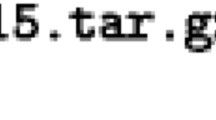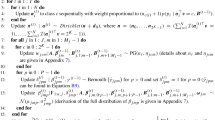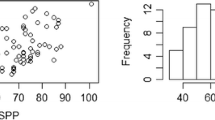Abstract
When modeling the relationship between two nominal categorical variables, it is often desirable to include covariates to understand how individuals differ in their response behavior. Typically, however, not all the relevant covariates are available, with the result that the measured variables cannot fully account for the associations between the nominal variables. Under the assumption that the observed and unobserved variables follow a homogeneous conditional Gaussian distribution, this paper proposesRC(M) regression models to decompose the residual associations between the polytomous variables. Based on Goodman's (1979, 1985)RC(M) association model, a distinctive feature ofRC(M) regression models is that they facilitate the joint estimation of effects due to manifest and omitted (continuous) variables without requiring numerical integration. TheRC(M) regression models are illustrated using data from the High School and Beyond study (Tatsuoka & Lohnes, 1988).
Similar content being viewed by others
References
Afifi, A.A., & Elashoff, R.M. (1969). Multivariate two sample tests with dichotomous and continuous variables. I. The location model.The Annals of Mathematical Statistics, 40, 290–298.
Batts, D., & Watts, D.G. (1988)Nonlinear regression analysis and its applications. NY: Wiley.
Breen, R. (1994). Individual level models for mobility tables and other cross-classifications.Sociological Methods and Research, 23, 147–173.
Clogg, C.C., & Shihadeh, E.S. (1994).Statistical models for ordinal variables. Thousand Oaks, CA: Sage.
Eliason, S.R. (1995). Modeling manifest and latent dimensions of associations in two-way cross-classifications.Sociological Methodology, 24, 30–67.
Gibbons, R.D., Hedeker, D., Charles, S.C., & Frisch, P. (1994). A random-effects probit model for predicting medical malpractice claims.Journal of the American Statistical Association, 89, 760–767.
Goodman, L.A. (1979). Simple models for the analysis of association in cross-classifications having ordered categories.Journal of the American Statistical Association, 74, 537–552.
Goodman, L.A. (1985). The analysis of cross-classified data having ordered and/or unordered categories: Association models, correlation models, and asymmetry models for contingency tables with or without missing entries.The Annals of Statistics, 13, 10–69.
Hedeker, D., & Gibbons, R.D. (1994). A random-effects ordinal regression model for multilevel analysis.Biometrics, 50, 933–944.
Krzanowski, W.J. (1980). Mixtures of continuous and categorical variables in discriminant analysis.Biometrics, 36, 493–499.
Krzanowski, W.J. (1983). Distance between populations using mixed continuous and categorical variables.Biometrika, 70, 235–243.
Kraznowski, W.J. (1988).Principles of multivariate analysis. NY: Oxford.
Lauritzen, S.L. (1996).Graphical models. New York: Oxford Press.
Lauritzen, S.L., & Wermuth, N. (1989). Graphical models for associations between variables, some of which are qualitative and some quantitative.The Annals of Statistics, 17, 31–57.
Olkin, I., and Tate, R.F. (1960). Multivariate correlation models with mixed discrete and continuous variables.The Annals of Mathematical Statistics, 32, 448–465.
Tasuoka, M.M., & Lohnes, P.R. (1988).Multivariate Analysis: Techniques for educational and psychological research (2nd ed.). New York: Macmillan Publishing.
Whittaker, J. (1989). Discussion of paper by van der Heijden, de Falguerolles & de Leeuw.Applied Statistics, 38, 278–279.
Author information
Authors and Affiliations
Corresponding author
Additional information
This article was accepted for publication, when Willem J. Heiser was the Editor ofPsychometrika. This research was supported by grants from the National Science Foundation (#SBR96-17510 and #SBR94-09531) and the Bureau of Educational Research at the University of Illinois. We thank Jee-Seon Kim for comments and computational assistance.
Rights and permissions
About this article
Cite this article
Anderson, C.J., Böckenholt, U. Graphical regression models for polytomous variables. Psychometrika 65, 497–509 (2000). https://doi.org/10.1007/BF02296340
Received:
Revised:
Issue Date:
DOI: https://doi.org/10.1007/BF02296340




